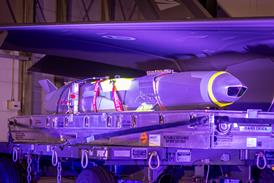Guy Norris/LOS ANGELES
THE McDONNELL Douglas (MDC)-led Joint Advanced Strike Technology (JAST) team will decide by the end of this month on a lift-fan-engine supplier for its design after dropping the alternative gas-coupled lift fan in favour of a "more affordable" lift-plus-lift-cruise concept.
The late shift to the Yakovlev Yak-38-like vertical-lift concept also involved dropping the General Electric YF-120 variable-cycle engine in favour of the Pratt & Whitney F119.
"Going with the F119 engine made the most sense at this stage, in terms of affordability," says MDC, which is now formally teamed with Northrop Grumman and British Aerospace on the JAST effort.
The move means that all three JAST teams (led by Boeing, Lockheed and MDC) are now using the F119 as the core power plant.
MDC is considering lift-engine bids from General Electric-Allison and Rolls-Royce. The GE-Allison bid is based on joint Integrated High Performance Turbine Engine Technology developed under its military-engine teaming effort announced in July 1994, before the R-R purchase of Allison.
R-R is basing its bid on lift-engine work already performed for Northrop Grumman under a $2 million study contract. The UK Company initially studied mating the core of the Eurojet EJ200 with the fan of a Tay turbofan, but found that the core was too long to fit in the small fuselage area. The 70kN (16,000lb)-thrust lift engine must fit into an area measuring roughly 1.15 x 1.15m.
The company is now believed to be looking at a de-staged BMW R-R BR700 core with a reduced pressure ratio. The engine will also be offered with a "squat" fan, slim-line guide vanes and a narrower combustion chamber. Based on earlier statements by Northrop - which, until its bid merger with MDC, was the only company with a lift-plus-lift-cruise JAST solution - the requirement calls for a simple engine with a short duty cycle.
MDC opted for the new arrangement over the gas-coupled fan because of affordability. The team says that the advantage of the modular lift engine, which can be replaced with a tank holding more than 500kg of fuel in the conventional take-off versions, outweigh the disadvantages.
These include the cost of the lift-engine development, plus the reliability and maintenance impact of two engines. Advantages include more dedicated tailoring of engine requirements to meet lift and cruise, better aerodynamic integration, manufacturing modularity and, as demonstrated by Yakovlev, which is helping the Lockheed JAST effort, it is a proven short take-off, vertical-landing concept.
MDC says that it is still evaluating potential uses for "...the full-scale concept demonstrator built for gas-coupled tests", and will almost certainly "...use it for continuing risk-mitigation efforts on the JAST programme".
Source: Flight International











































